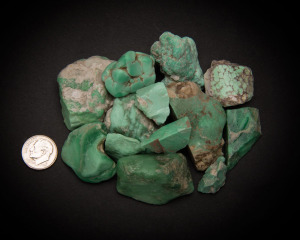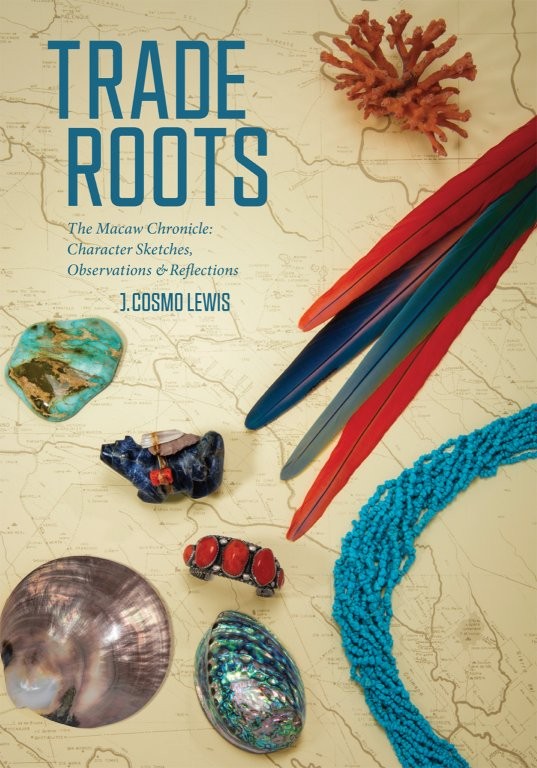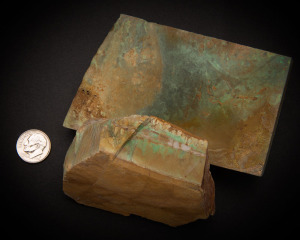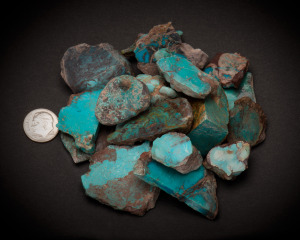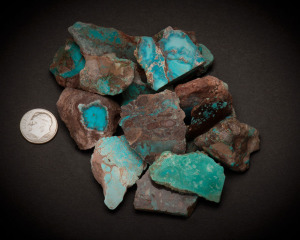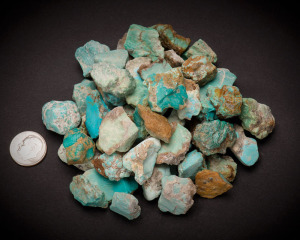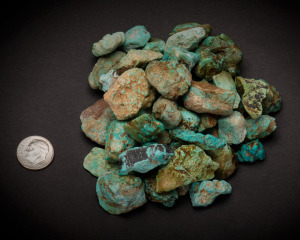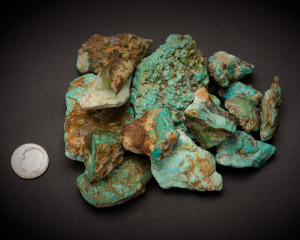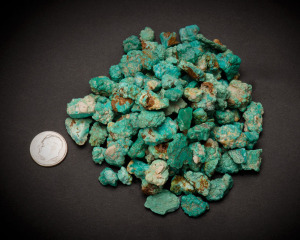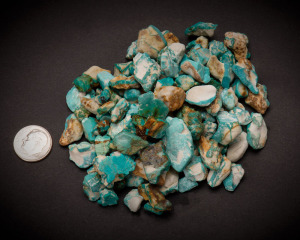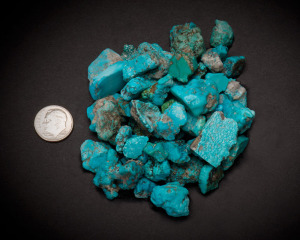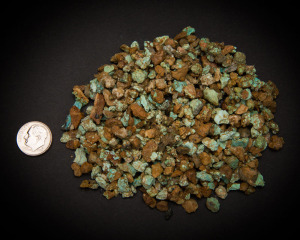Turquoise Mines
Ajax Turquoise Mine
The Ajax mine, a small mine located in south central Nevada in the Royston area, is one of the relatively new turquoise mines. The mine yields stones from light blue with darker blue veins to predominately dark green with light blue areas. This latter coloration is considered quite unusual for turquoise.
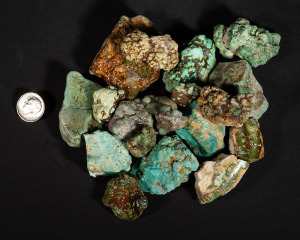
Arizona Blue Turquoise Mine
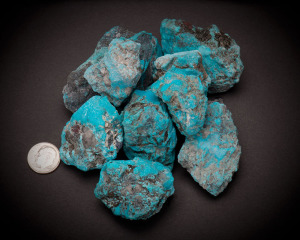
Arizona Blue
Bisbee Turquoise Mine
“Bisbee Blue” is a name given to turquoise that originates from the Bisbee Mine, near Bisbee, Arizona, in Cochise County, USA. The term refers to the turquoise that comes from copper mines in this region. Turquoise from the Bisbee mine has a reputation as a hard, finely webbed stone with high blue color, ranging from sky blue to a dark lavender blue. The matrix patterns vary a great deal, but can be characterized by the deep chocolate brown to black webbing. The hardness is 4.5 on the mohs scale.
The name “Bisbee” conjures a mystique among all turquoise aficionados, and it is one of the most sought after of all domestic turquoise. The turquoise from Bisbee is highly collectible and it is one of the more famous of the American mines. Although the turquoise from the Bisbee mine has a wide variety of color and hardness, the most exceptional quality originates from the Lavender Pit, especially the east side. Such stone has beautiful high blue color with a dark distinct matrix. The turquoise is found as stringers that form as much as a few inches wide, as well as minute stringers in pyrite; also, small nugget masses in granite and quartz.
Bisbee mine turquoise was one of the first to appear for sale on the modern American market, which is at least partly responsible for its fame. The turquoise mine was a secondary operation to the Bisbee copper mine, operated by the Phelps Dodge Corporation. The vast majority of Bisbee turquoise surfaced when the Phelps Dodge started their open pit mining operations at the location now known as the Lavender Pit.The mine has been closed since the early 1970's, so anything new coming from the mine has been scavenged from the old dumps.
Much conglomerate rock had to be removed by Phelps Dodge before the deeper copper ore could be mined. This conglomerate was considered waste rock to the mining company, but was actually a hidden treasure as the host rock for Bisbee turquoise. This waste was discarded in huge piles called "dumps." The corporation made no decided effort to recover the turquoise, so almost all of it was recovered by company employees taking it out covertly in lunch boxes. Though this activity was prohibited, it was rarely enforced. For several years, through the late 1970’s, these individuals (locally known as "dumpers"), were the only source for this fine turquoise. Also, during this time, Phelps Dodge began leasing out rights to individuals to mine the dumps for turquoise. However, the large majority of Bisbee turquoise was extracted during the 1950’s and 1960’s through the covert actions of mine employees.
There are other very rare materials from Bisbee that were mined both from stream beds in the Mule Mountains, as well as from the Campbell shaft. The various lesser-known formations, other than turquoise, among the copper oxides of Bisbee are of interest, as they rarely form in a similar way anywhere else in the world. There is a conglomerate mix of Azurite, chatoyant malachite, chrysacola and cuprite…all in a single stone, coming from the Campbell Pit, that is incredibly understated and altogether unrecognized for its uniqueness.
In 2004, Phelps Dodge Corporation decided to bury the old mine under hundreds of tons of dirt and rock. They felt that the miners, due to the increasing value of the turquoise, were paying too much attention to the turquoise and not enough to copper mining.
Blue Diamond Turquoise Mine
The Blue Diamond mine is located south of Austin, Nevada, and produces a very hard light to deep blue turquoise, with an attractive swirl or mottled pattern of light and dark blues. It has brown to black matrix. The mine is located at a high altitude and cannot be mined in the winter months due to the extreme cold and snow.
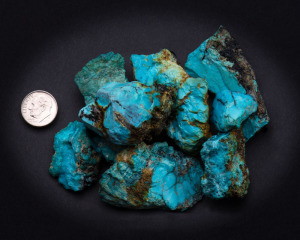
Blue Diamond
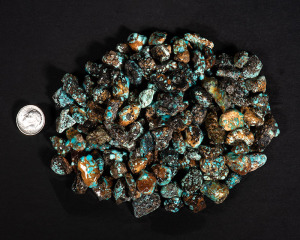
Blue Diamond Nuggets
Blue Gem Turquoise Mine
The Blue Gem Lease Mine has been staked also as the Turquoise Tunnel and the Contention, and at one time it was on the Pedro Lode claim belonging to the Copper Canyon Mining Company. The Blue Gem mine is located south of Battle Mountain, in the SE 1/4 of Section 29, T. 32 N., R. 44 E., at about 4,000 feet north - northeast of Copper Basin. It is surrounded by the copper workings of the Copper Canyon Mining Co. The parent company is the Duval Corporation.
Blue Gem turquoise occurs in argillized quartz monzonite cut by two limonite-stained sheer zones, one trending N. 35 o W. and dipping 75 o NE., the other trending N, 25 o E. and dipping 55 o NW. An extensive breccia zone about 10 feet wide is developed between the two bounding sheers. Exceptionally good quality turquoise forms veinlets up to three-quarters of an inch thick along the shears. Pyrite-bearing quartz veins are closely associated with the turquoise.
The Blue Gem mine was at one time located deep underground, accessed by tunnels as deep as 800 feet. This is of interest because the Blue Gem Mine and the Bisbee Mine in Arizona are the only two mines (of which we are aware) that turquoise was found that deep in the earth. The Blue Gem mine was once developed in extensive underground workings. An adit several hundred feet long on the main structure connected to numerous shorter tunnels and several open stopes. Directly above the main adit was a glory hole some 100 feet long.
The Blue Gem deposit was first noted by Duke Goff in 1934. It was subsequently leased from the Copper Canyon Mining Co. by the American Gem Co. of San Gabriel, CA., owned by Doc Wilson and his sons, Del and William. The company operated the property until 1941 when the outbreak of the war caused a shortage of experienced miners. When both Del and William Wilson were called into the Army, the mine was closed for the duration of the war. Consequently, the lease was allowed to lapse and work was abandoned. In 1950 the mine was leased by Lee Hand and Alvin Layton of Battle Mountain.
In the early days of the operation, production of turquoise at the Blue Gem Lease was enormous. Although there is no exact information, it is reported that the output amounted to nearly $1 million in rough turquoise. The mine is still active, although it is currently in the center of a major copper deposit being developed by Duval Corp.
Pyrite in Blue Gem is unusual to see but not unheard of. Very little large material ever came out of the Blue Gem Turquoise mine. The majority found was small 1-3 mm "bleeder" veins, which often came in sheets measuring 2 inches x 2 inches, as well as tiny nuggets which was perfect for Zuni inlay and fine needlepoint, petit-point and snake-eyes jewelry. Blue Gem turquoise was very popular in the late 1930's and 40's and was commonly used in the Fred Harvey "railroad and tourist jewelry" - the blue jewel - that is so collectable today. Blue Gem turquoise is extremely hard and stands up well to the test of time.
Blue Gem turquoise is a rare, valuable and historic American treasure. Quality Blue Gem Turquoise has been gifted with a wide range and variety of color, from a beautiful sky blue to an aqua blue-green, not unlike parts of the Mediterranean Sea. Because Blue Gem turquoise is very hard, a high polish is associated with this gemstone, and unlike most blue turquoise, it won't easily change color. This jewel's blue turquoise stone has a unique character and many different looks all of which are striking, full of wonder and pleasing to the eye.
Production of the mine started about 1934 and continued into the 1970's. Blue Gem Turquoise is still some of the finest turquoise ever found, and unlike most turquoise mines, (in which the majority mined is chalky and only usable if stabilized) most of the turquoise found there was of gem-quality. Today the Blue Gem mine can no longer be worked, as it sits in the middle of a huge mining operation. The emphasis is on precious metals; the extraction of turquoise is considered more of a hindrance in the mining process than an asset. Even the ever popular "Dump Diving" for turquoise is not tolerated due to the very real danger of becoming buried in a slide. Insurance factors, equipment hazards, high explosives and safety issues, along with a lack of interest from the mining company, keep Blue Gem turquoise unavailable to the world, at least for now.
The original Battle Mountain blue Gem Mine no longer produces turquoise, although numerous other mines in the area now carry the same name. The only true old Blue Gem turquoise available today is through old collections.
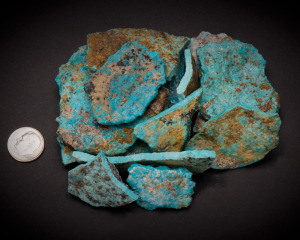
Blue Gem I
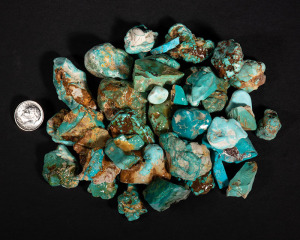
Blue Gem II
Carico Lake Turquoise Mine
Cairo Lake Turquoise is named after the location of its mine, located on a dried up lake bed in a high, cool area of Lander County, Nevada. It’s clear, iridescent, spring green color is due to its zinc content and is highly unique and collectible. Carico Lake turquoise is also found in a dark blue as well as a blue-green color with a black, spider web matrix. The Carico Lake mine is primarily a gold producing mine. However, from time to time, the mining company leases the turquoise producing part of the mine to individual miners who are permitted to work that part. The limited amount of time allowed to mine Carico Lake turquoise and the limited amount of turquoise yielded, combine to make Carico Lake turquoise a valuable addition to one's collection.
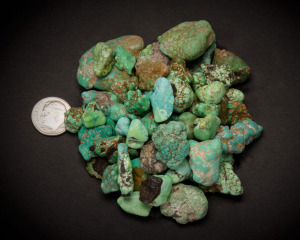
Carico Lake I, Lime Green
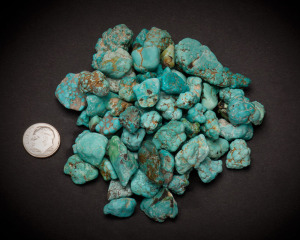
Carico Lake II, Select Blue
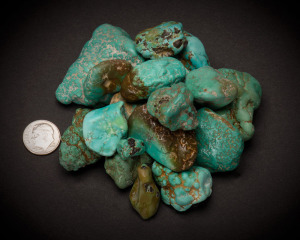
Carico Lake III, Select Green
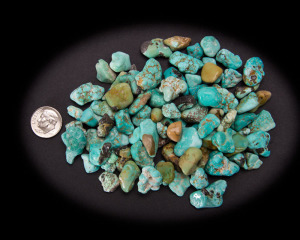
Carico Lake IV, Mixed Blues
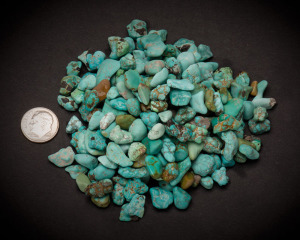
Carico Lake V, Nugget
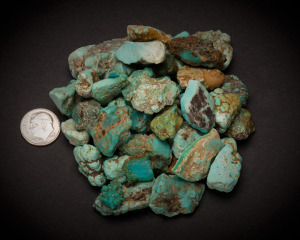
Carico Lake VI, Mixed Colors CA 1970's
Crescent Valley Turquoise Mine
There are many turquoise mines in Crescent Valley, the name is a catchall for them. Many are small esoteric mines that can only be worked by shovel and access by foot or horse. Some of the more famous names are the Blue Goose and Montezuma mines.
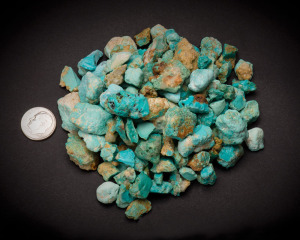
Crescent Valley N - Montezuma
Cripple Creek Turquoise Mine
Cripple Creak Turquoise comes from the Cripple Creek mining area, located in Teller County Colorado, near the town of Cripple Creek. This is a very hard stone with colour range from light and dark blues with brown matrix, and more rarely a golden limonite matrix to blue-green. Hardness can be up to 6 mohs. The best use over all is for inlay and cabbing, although the medium quality is often a little pithy or porous, the result of which does not become visible until the end of the polishing process. This turquoise, like Carico Lake turquoise, is found as a by product of gold mining. This stone is found as both vein material and nodules.
This history of Cripple Creek Turquoise is quite interesting. One of the last great Colorado bonanza camps, the district was first discovered in 1891 by cowboy Bob Womack and turned out to be one of the richest gold mining camps in US history. The 500 mines in the area have yielded over 600 metric tons of gold, making it the third most productive gold district in the history of the United States.
Cripple Creek is unusual in that it is one of only a few domestic Turquoise mines still active today, although production has been limited. There are currently two active turquoise mines in the area being operated by two different families. The area is also quite mineral rich; along with gold and turquoise, over 120 other mineral species have been found.
Damale Turquoise Mine
The Damale mine is a small, tightly run operation, located thirty miles northeast of Austin, Nevada. The mine is located next to the Godber-Burnham mine, on The Dry Creek Ranch owned by the Damale family. There, they raise unique horses that carry the Damale name. Benny Damele discovered the mine sometime around 1973. Soon thereafter, Clyde Wright became involved in mining the claim and worked it for approximately 18 years. Tony Cotner, a shrewd merchandiser and colorful character, has owned the claim since 1990 when he bought it from Benny Damele. Cotner, also known as "Mean Green", states there is an ancient subtropical zone located beneath the mine that may be responsible for the unusual colors associated with Damele turquoise although he is unsure whether the organic environment has anything to do with the coloration.
Damale is a well known mine, distinctive because it is one of the few turquoises that can be truly yellow-green, either from iron or environmental conditions, but without zinc. Turquoise from the Damale mine is wonderfully distinctive; very hard, and visually appealing. It forms in veins and occasionally as nuggets in carbonaceous chert and also diatomaceous earth. Much of the production from this mine is a high grade variscite, a “first cousin” to the turquoise.
The mine is extraordinarily versatile, it’s colors ranging from pure lime-green through bright chartreuse; it can also be yellow with black webbing, or white, orange and brown, or even a caramel color with bright green polka dots. The mine also produces small black nuggets with bright yellow-green bumps poking out of the black matrix. It’s availability is extremely limited because the mine is small and difficult to work. Due both to its limited quantity as well as its rare color and quality, turquoise from the Damale is an exceedingly collectible turquoise.
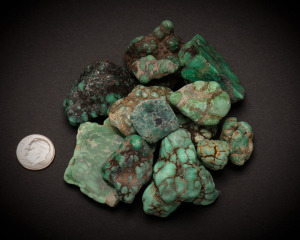
Damale A Grade
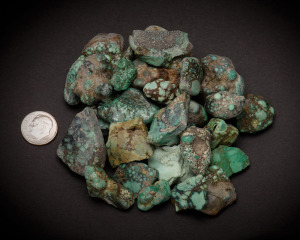
Damale B grade
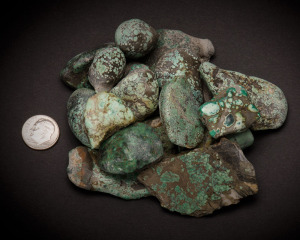
Damale C grade
Evans Turquoise Mine
The Evans Mine is located in Baja, California. It is one of the few mines south of the border that has yielded such a wide variety of turquoise. Colors range from a high blue with a beautiful brown matrix to a green with gold matrix. The formation runs from thin veins of dark blue turquoise to nuggets to flats. There is an extremely limited amount of this material on the market because the mine was covered up in the 1990’s.
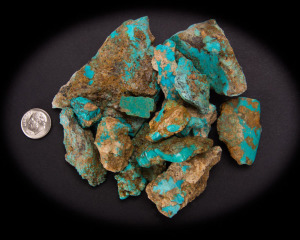
Evans Cabbing Rough
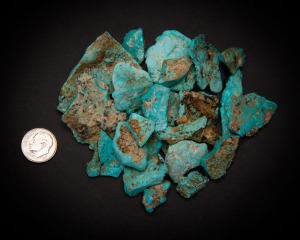
Evans High Grade
Fox Turquoise Mine
The origin of the Old Fox mine is near Lander County, Nevada. While indigenous people found large nuggets in this area in prehistoric times, the area was first discovered for contemporary mining purposes in the early 1900’s. In the 1940's, Dowell Ward purchased & developed the old Cortez claims. Turquoise from this mine comes under several different names including Fox, White Horse, Green Tree and Smith, to differentiate the different deposits and colors and to create a larger perceived share of the turquoise market. Color range is from a soft sky blues, sometimes with a subtle water-marked matrix, to blue-green to green. While quite a bit of this material came out in nugget form, there is also large seam material, sometimes as thick as two inches. The colors in the seam material go to a deeper green, sometimes in conjunction with a very nice blue. The nugget material, while usually small, makes very nice cabs or can be used for inlay. The seam material, often not of ultra high quality, is better suited for carving and, with the better quality for cabbing. Hardness is 4.5.
Gold Canyon Turquoise Mine
Sonoran Blue Gold Canyon Turquoise is an interesting turquoise from Senora, Mexico, near Nogales, Arizona and its neighbor: Nogales, Mexico, which is the northernmost point in all of Mexico. The series of mines bearing this name are on several sites contingent to the American border. Very little hard natural material has been mined here. Most has needed stabilizing to be useful. The high grade natural material is a medium blue, with darker blue matrix, forming a “birds eye” pattern. This is usually accompanied by iron pyrite, giving it a similar look to a high grade Morenci. The high grade turquoise from this mine is rare and is considered both esoteric and valuable.
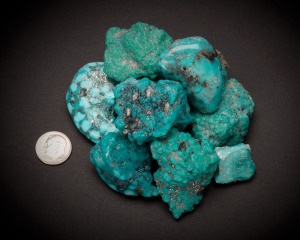
Gold Canyon
Cloud Mountain Turquoise
Cloud Mountain turquoise comes from a mine in the Hubei Province in central China that has been the most prolific mine in Asia. The Mohs hardness ranges from a 4 to 5.5. The qualities of turquoise that come from Hubei range from very soft material, needing to be treated to make it usable, to an attractive green spider web, to a very hard and fine blue with dark veined (spider web) matrix that could be considered some of the world’s finest turquoise.
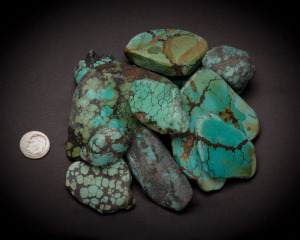
Cloud Mountain Green Spiderweb III
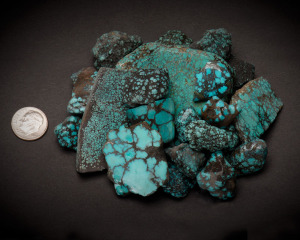
Cloud Mountain Gem Grade Fine Blue Spiderweb I
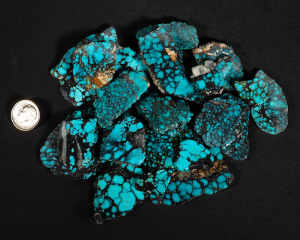
Cloud Mountain Gem Grade Spiderweb Slabs II
Kingman Turquoise Mine
Kingman Turquoise originates in the Mineral Park Mining District near Kingman, Arizona. One of the largest domestic turquoise mines, it is found in a large open pit copper mine in the high desert country. The Kingman Mine district was first mined by Native Americans; it was part of the most extensive prehistoric workings in Arizona.
However, modern production of turquoise dates back to the 1880's when James Haas rediscovered the area. Natural Kingman Turquoise ranges in color from light to very dark blue and sometimes tints of green. Matrix can range from white, light brown to black and frequently flecked with pyrite and occasionally quartz. The most famous stones from this mine are rounded bright blue nuggets with black matrix. Few turquoise mines produced nuggets, especially of this quality. In its high-grade form it has always been considered among the top quality American turquoise. This high blue color has become a “color standard” in the industry, reflected by the name “Kingman Blue”. However, much of the turquoise from Kingman occurs as seams, masses and veins, rather then in nugget form. Besides the nugget form, the most desirable Kingman turquoise is a deep blue with molybdenum pyrite; also, deep blue with pyrite as well as in a “bird's eye” pattern with “water web” matrix.
The mine is currently owned & Operated by the Colbaugh family’s company, Colbaugh Processing. While old natural Kingman turquoise is rare, they have recently gone back into older sections of the Kingman mine and are bringing out some new natural Kingman Turquoise. Although there are quantities of this fine natural deep blue turquoise available, the largest percentage of turquoise mined at Kingman is being treated or stabilized. There are several other names for the turquoise coming out of the Kingman mining district: Ithaca Peak, Old Man Mine, Kingman Duval, Courtland, The Wall and Turquoise Mountain, just to mention a few.
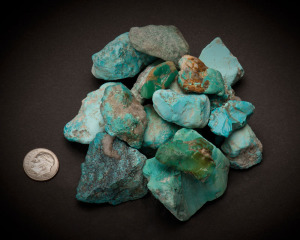
Kingman Duval Turquoise
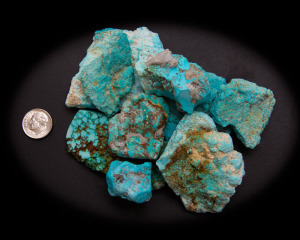
Kingman Old 1970's Turquoise Mountain
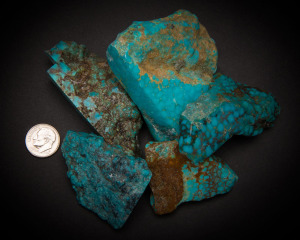
Kingman Old 1970's Turquoise Mountain Stabilized Super High Grade Spider Web
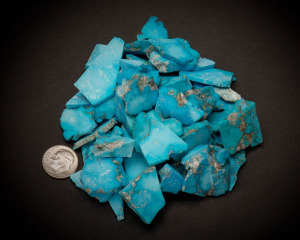
Kingman Turquoise Birdseye Slabs ca. 1970's
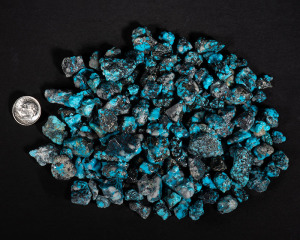
Kingman Turquoise Black Spiderweb
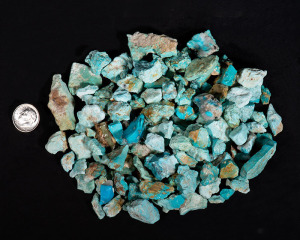
Kingman Turquoise Inlay Material
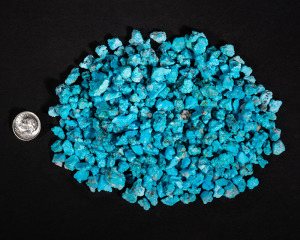
Kingman Turquoise Nuggets
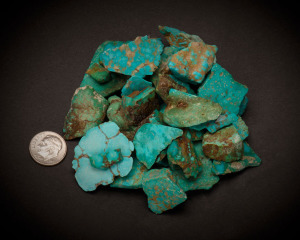
Kingman Turquoise, Old Man Mine, Cut Pieces CA 1980's
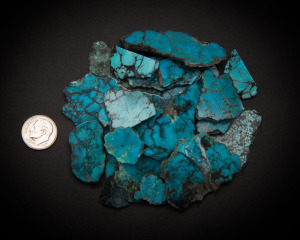
Kingman Turquoise, Stabilized 1970s Spiderweb Slabs
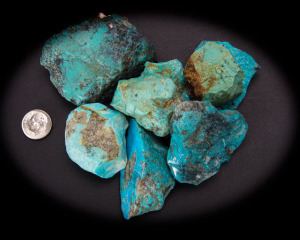
Kingman Turquoise, Stabilized Blue Green to Green
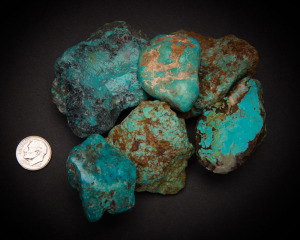
Kingman Turquoise, Stabilized Blue with Light Matrix
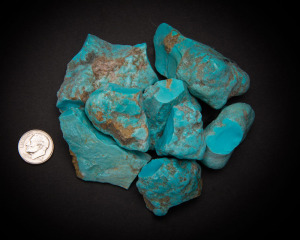
Kingman Turquoise, Stabilized Clear Blue
Maanshan Turquoise Mine
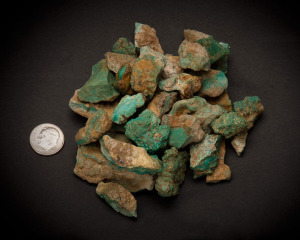
Maanshan Emerald Valley Green
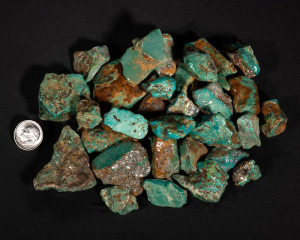
Maanshan Emerald Vally Green Stabilized
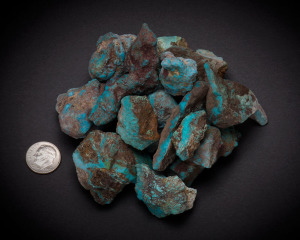
Maanshan, Emerald Valley Blue
Morenci Turquoise Mine
Morenci Turquoise is mined in southeastern Arizona, in Greenlee County. It is light blue to high blue in color. Morenci has an unusual matrix of irregular black pyrite, or fool’s gold; when polished, the pyrite often looks like silver. It also is sometimes webbed in a darker shade of blue, called water webbed. Morenci turquoise is well known because it was one of the first American turquoises to come on the modern market, and is often difficult to obtain because the mine is now depleted, making it an exceedingly collectible turquoise.
Material coming out in the 1960’s seems to be harder, tending more to the blue-greens, usually with the pyrite. In the 1970’s, the material was a much brighter blue, often with quartz along with the pyrite.
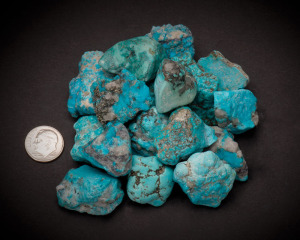
Morenci II
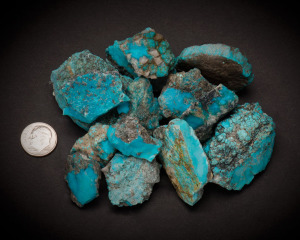
Morenci III
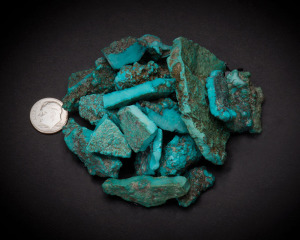
Morenci IV
Northern Lights Turquoise Mine
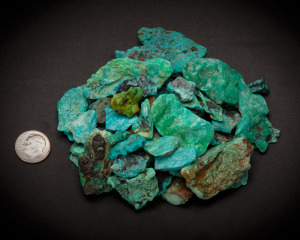
Northern Lights
Number 8 Turquoise Mine
Located in the Lynn mining district (no. 19, pl. 1 ) in northern Eureka County, north of Carlin, Nevada, the Number 8 turquoise mine is on the west side of the Tuscarora Range in the NW 1/4 sec. 4, T. 35 N., R. 50 E., and was at one time a gold and copper mining operation. It was in a large mining district encompassing ten 20-acre claims and was active from the 1930’s through the early 1950’s. Host rocks for the Number 8 deposit consist of intensely altered quartz monzonite, shale, and thinly bedded black chert, which are complexly folded, faulted, and much altered. Turquoise is concentrated along quartz veins in the intrusive rock and along faults in the sedimentary rocks.
History of the Number 8 Turquoise Mine
The number 8 mine was presumably discovered about 1925 by a barber from Carlin whose name has been forgotten, because he made no attempt to mine the property. The mine was rediscovered by Earl Buffington and Lawrence Springer in 1929. They filed formal claim to the property and proceeded to mine turquoise in serious fashion, producing about 1,800 pounds of good stone the first year. In 1930 Ted Johnson bought Buffington's interest and during the next four years produced about 5,000 pounds of commercial stone. In 1935 Doc Wilson bought the number 8 mine from Johnson but did nothing with the property and the claim lapsed. Myron Clark relocated the claim and, after working it for awhile, sold it to Lee Hand. Hand operated the mine for a short time, but became dissatisfied with the quality of the stone, and sold it to the five Edgar brothers who now own it. The Edgars extended operations and produced a considerable amount of fair-to-good turquoise.
In 1950, as most of the visible turquoise had been taken from the workings, the Edgars hired a contractor with bulldozer equipment to remove overburden from another part of the claim. A deposit of copper had been found on the property, and the Edgars thought they might mine copper if they did not find more turquoise. The bulldozer, after digging a pit about eight feet deep and 80 feet long, uncovered a deposit of some of the finest spider-web turquoise ever found in Nevada. The deposit was mostly in nodules, some of gigantic size.
Number 8 Turquoise
One of the largest pieces of turquoise and matrix in the modern world, perhaps the largest nodule ever uncovered, was discovered at the Number 8 mine on June 23, 1954, by T. G. Edgar, J. M. Edgar, and Marvin Symes. This specimen was 33 inches long, 18.5 inches wide, and seven inches thick. Cleaned and polished it weighed 150 pounds. The nodule was of excellent texture, good color and hardness, and ranked with any turquoise of good commercial grade. Another nodule, of excellent quality, weighed more than nine pounds. It was sold to C. G. Wallace, of Zuni, New Mexico, for $1,600. The discovery proved to be a rather large-pocket and produced more than 1,600 pounds of the very highest grade turquoise before being worked out. Spurred by this find, the Edgars further explored the property, without finding any more spider-web turquoise of notable quantity. Other turquoise was discovered, however, of good commercial grade, sufficient to keep the mine in operation.
Of the ten claims in this 20-acre area, the Number 8, first claimed by the Blue Star Company in Lander County, is considered the finest example of the gold-webbed turquoise. The mine has produced one of the most prized spider web turquoise deposits in the world. In its prime, enormous nodules were found, including one that weighed 150 pounds. Number 8 turquoise is famous for its black, golden-red and brown spider web matrix background, which is set off by the soft blue to blue green turquoise. Only rarely does gem material appear: a very dark blue turquoise with black spider web matrix. The mine is now depleted and Number 8 turquoise is extremely rare and valuable.
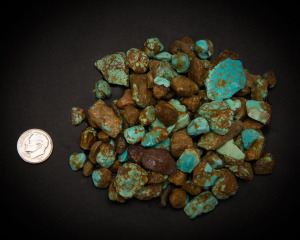
Number 8 Mine IV, Stabilized
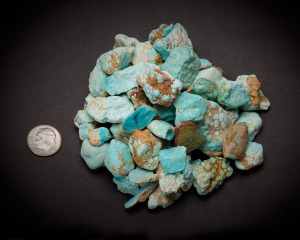
Number 8 Turquoise - I Mixed Blues
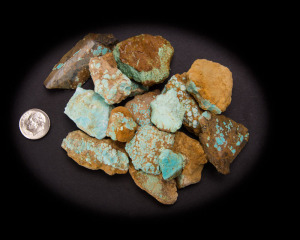
Number 8 Turquoise III, Mine Run
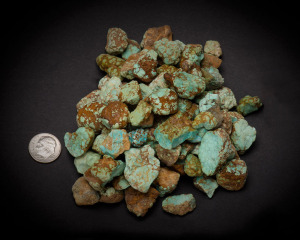
Number 8 Turquoise-II Mixed Blue Greens with Brown Spiderweb
Pilot Mountain Turquoise Mine
The Pilot Mountain turquoise mine is located in northern Nevada, in Mineral County, near the town of Tonapah. It is still producing and is worked by one family. Pilot Mountain turquoise stone is highly admired for its deep blue-green colors. In addition, it can show light blue to dark green colors on the same stone. This graduation in color is unusual and makes Pilot Mountain turquoise very collectible. The matrix is black to golden brown. Although sometimes a little porous, or pithy, the Pilot Mountain turquoise we have for sale is a hard stone and takes a good polish.
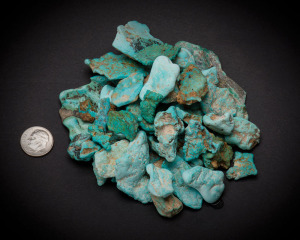
Pilot Mountain
Royston Turquoise Mine
Royston is a district in Nevada consisting of three turquoise mines: Bunker Hill, Oscar Wehrend, and the main producer, The Royal Blue. Royston is known for its beautiful colors ranging from deep green to rich, light blues which are set off by a heavy brown matrix. The Royston mine is producing a little high grade turquoise today, operated by the Ottison family. They process most of their material into finished cabs and allow very little rough to come onto the market. This controlled output has raised the price of this material considerably in recent years.
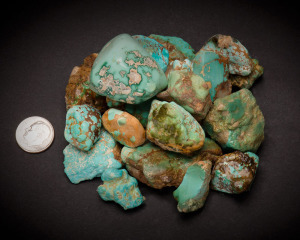
Royston
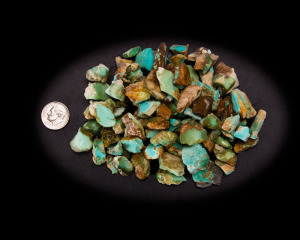
Royston Small
Sleeping Beauty Turquoise Mine
The Sleeping Beauty Mine is located in Globe, Arizona, but is no longer an active mine. For many years it produced a wide range of turquoise that is now even more highly prized for it's solid soft blue color, with little or no matrix. The color of sleeping beauty turquoise ranges from a deep royal blue to a light sky blue. originally, the Sleeping beauty turquoise mine was worked for copper and gold but during the last five decades or so it produced gemstone quality turquoise in quantities to satisfy the commercial market. In general, the miners lease portions of the “dumps” and sort turquoise from there.
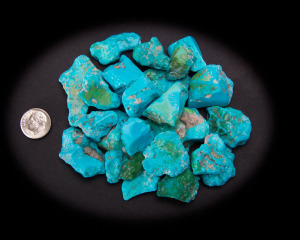
Sleeping Beauty Enhanced
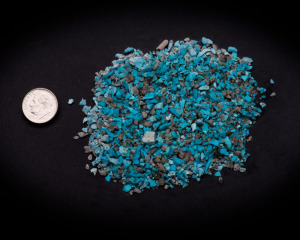
Sleeping Beauty, A Grade Chips
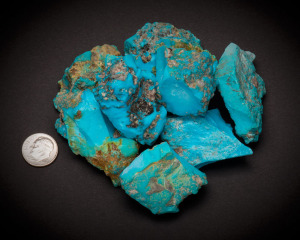
Sleeping Beauty, A-Grade, Extra Extra Extra Large
These are huge pieces mined in the 1970's. Very large pieces in a soft blue color.
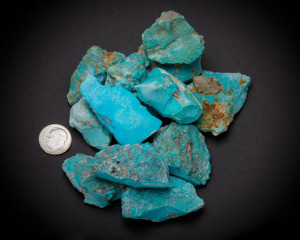
Sleeping Beauty, A-Grade, Extra Extra Large
This clear blue material was mined in the 1970's, when we all thought this material would be available forever. The mine ran out of turquoise + is now closed, making this material rare and in high demand.
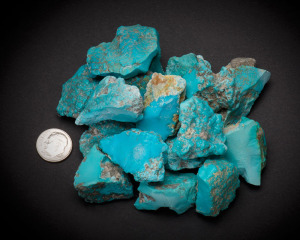
Sleeping Beauty, A-Grade, Extra Large
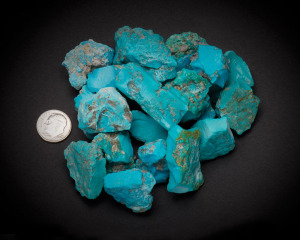
Sleeping Beauty, A-Grade, Large
This clear blue material was mined in the 1970's, when we all thought this material would be available forever. The mine ran out of turquoise + is now closed, making this material rare and in high demand.
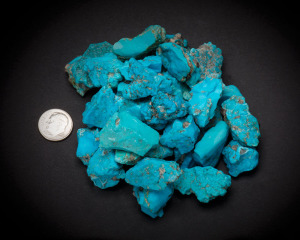
Sleeping Beauty, A-Grade, Medium
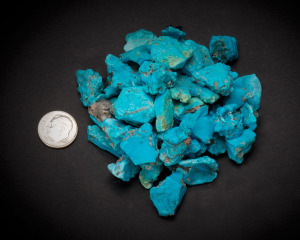
Sleeping Beauty, A-Grade, Small
This clear blue material was mined in the 1970's, when we all thought this material would be available forever. The mine ran out of turquoise and is now closed, making this material rare and in high demand.
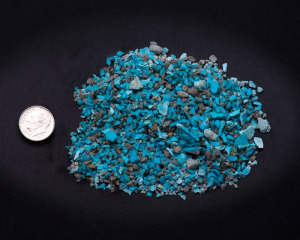
Sleeping Beauty, B Grade Chips
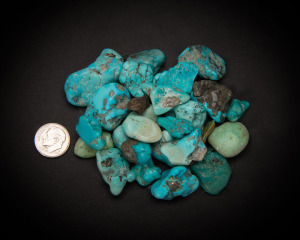
Sleeping Beauty, B-Grade, Tumbled
Other Turquoise and Variscite Mines
There is a small town in south central Italy, near Naples, famous for its cameos. Their needs for huge quantities of this material over the years have always kept the supply down and demand high. The clear blue is reminiscent of old Persian turquoise, and is without doubt the most preferred and prized by Europeans, both for cameos as well as in bead or jewelry form.
There is a sister mine nearby, called the Bluebird, that produces some of the world’s most beautiful azurite. This material is a copper oxide and also contains malachite, crysacolla as well as a mineralized copper or cuprite. This is a rare and undervalued gem stone that has all but disappeared from the marketplace.
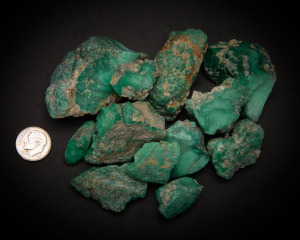
Broken Arrow Variscite
